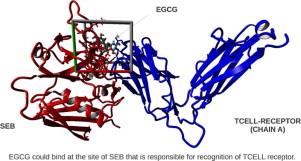Binding of flavonoids to staphylococcal enterotoxin B |
| |
| Affiliation: | 1. Biotechnical Faculty, University of Ljubljana, Jamnikarjeva 101, 1000 Ljubljana, Slovenia;2. Faculty of Chemistry and Chemical Technology, University of Ljubljana, Aškerčeva 5, 1000 Ljubljana, Slovenia;3. Centre of Excellence for Integrated Approaches in Chemistry and Biology of Proteins (CipKeBiP), Jamova 39, Ljubljana, Slovenia;1. Department of Computer Science, Universidade Federal de Minas Gerais, Belo Horizonte, MG, Brazil;2. Instituto de Informática, Universidade Federal de Goiás, Goiânia, GO, Brazil;3. Department of Computer Science, Universidade Federal de São João Del Rei São João Del Rei, MG, Brazil |
| |
| Abstract: | 
Staphylococcal enterotoxins are metabolic products of Staphylococcus aureus that are responsible for the second-most-commonly reported type of food poisoning. Polyphenols are known to interact with proteins to form complexes, the properties of which depend on the structures of both the polyphenols and the protein. In the present study, we investigated the binding of four flavonoid polyphenols to Staphylococcal enterotoxin B (SEB) at pH 7.5 and 25 °C: (-)-epigallocatechin-3-gallate (EGCG), (-)-epigallocatechin (EGC), kaempferol-3-glucoside (KAM-G) and kaempferol (KAM). Fluorescence emission spectrometry and molecular docking were applied to compare experimentally determined binding parameters with molecular modeling. EGCG showed an order of magnitude higher binding constant (1.4 × 105 M−1) than the other studied polyphenols. Our blind-docking results showed that EGCG and similar polyphenolic ligands is likely to bind to the channel at the surface of SEB that is responsible for the recognition of the T-cell beta chain fragment and influence the adhesion of SEB to T cells. |
| |
| Keywords: | |
| 本文献已被 ScienceDirect 等数据库收录! |
|

